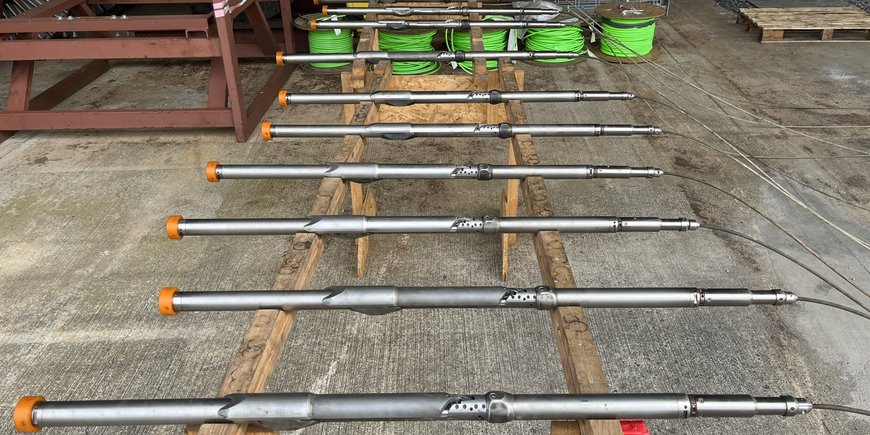Summary
In these days, the field experiment of the research project GEOREAL starts at the Deep Crustal Lab at the Continental Deep Drilling Program (KTB) in Windischeschenbach/Bavaria. Scientists of the GFZ German Research Centre for Geosciences want to test the permeability of the rock in the context of deep geothermal energy. The latest research approaches of hydraulic stimulation, i.e. injection of water, in the crystalline rock will be used for real-time monitoring of seismic activity. These approaches were last successfully tested in a similar experiment in a deep well in the Helsinki metropolitan area and will now be optimized. The use of geothermal energy in deep rock strata is an important building block for a regenerative heat and energy supply with great potential in Germany. The GEOREAL project is accompanied by two visitor days with lectures and guided tours on site at the drilling site.
Gigantic crush zone in the deep underground
Two deep boreholes have existed at the KTB site since 1994. They represent a globally unique access to fluid in rocks with a temperature well above 100 degrees Celsius; science refers to this as a petrothermal fluid reservoir. Crystalline bedrock at depths of more than three kilometers is typical of large parts of Germany's deep underground, but only in the northern Bavarian region, this has been well explored and made accessible for scientific experiments by the two KTB boreholes to a depth of nine kilometers.
Where a gentle hilly landscape stretches today, a huge mountain range rose more than 300 million years ago, the peaks of which have since been eroded away. The roots of these former mountains were detected in the two KTB boreholes. The drilled remains of this mountain range resemble a gigantic crush zone in the subsurface, which today still provide information about the collision of the continental plates at that time. This area is now to be explored for its geothermal potential by injecting water under pressure into the hot rock (“hydraulic stimulation”).
For this purpose, the GEOREAL team installed a chain of highly sensitive borehole seismometers – measuring vibrations similar to microphones – in the KTB main borehole to document the GEOREAL experiment with high precision at a depth of more than 3.8 km in the KTB pilot borehole. In addition, up to 50 more seismometers were installed on the surface around the KTB and in several 150-meter-deep boreholes. The data from the seismometers is transmitted to the drilling site and analyzed there in real time. “Nowhere else in the world do two wells of such depths, 4000 and 9101 meters, exist directly next to each other. Therefore, the KTB site is excellently suited for the project,” says project manager Dr. Carolin Böse.
Seismic rustle helps control pumps
The new experiment aims to better understand the processes in the geothermal reservoir, on the one hand, and to activate existing flow paths, consisting of many tiny cracks in the rock, at a depth of several kilometers, on the other hand, without triggering noticeable seismic activity at the surface. The “adaptive stimulation” method used for this purpose is based on automatic seismic real-time measurement: The effects of pressure build-up and quiescent phases during water injection on the spatial and temporal propagation of the water front in the reservoir are investigated in a targeted manner. These flow paths are indicated by microearthquakes that are not perceptible at the surface and are usually not measurable. Professor Dr. Marco Bohnhoff, head of the GFZ section “Geomechanics and Scientific Drilling” explains: “The detection of these microseismic crackles in the deep subsurface opens up the possibility for us to actively control the processes at a depth of almost four kilometers by directly adjusting the pumping rates during the experiment and thereby make this area more hydraulically permeable in a controlled manner.” This creates near-laboratory conditions below which these processes can already be controlled today. If the GEOREAL team also succeeds in doing this in the field experiment, then the use of the geological subsurface for heat pumping, but also, for example, for the safe storage of liquids and gases.
Precursor of the GEOREAL experiment
The GEOREAL experiment builds on injection experiments previously conducted at KTB and uses their results with new technology. Between 1994 and 2005, a total of three similar experiments were conducted at KTB, two of which involved injections in the open hole section of the KTB main well for days to months. Four years later, water pumping followed by water injection was conducted in the KTB pilot hole for nearly a year each. These experiments resulted in imperceptible, so-called induced seismicity. However, several hundred microearthquakes were recorded that occurred in the immediate vicinity of the stimulated borehole interval at depths of 3 kilometers and more. The strongest of these microearthquakes had a magnitude of 1.2, well below the human perceptibility threshold, which is about 2. For comparison, about 8,000 microearthquakes with a magnitude of 1 to 2 occur worldwide every day. Magnitudes of up to 4 or almost 5 occasionally occur about 80 kilometers away from the KTB in the Eger Basin. These are then clearly noticeable and can also cause damage near the epicenter.
After completion of the GEOREAL experiment, the geoscientists expect an improvement of existing procedures for the technical implementation of geothermal projects at the KTB site and beyond. GEOREAL is also the starting signal for a long-term reactivation of research at the historically important KTB science site in Windischeschenbach.
Visiting days:
Due to technical difficulties during the course of the experiment, we unfortunately have to cancel the visitor days.
(edited on 16th November 2023)
Update – status 12/12/2023: Premature termination of the experiments
During the GEOREAL project work, technical difficulties arose when installing the specially designed and manufactured “packer”. The packer was intended to hydraulically stimulate a limited depth segment in the lowest area of the KTB pilot bore. As this spatial limitation was no longer possible, the stimulation concept had to be adapted: Now the entire open area in the KTB pilot bore below approx. 3850 metres was to be stimulated to a reduced extent. However, the researchers ended the stimulation prematurely as fluid had flowed back to the surface via the annulus of the borehole.
This meant that the stimulation could not be realised to the planned extent. The evaluation of the measurement data collected before, during and after the stimulation has begun. The GEOREAL project team will shortly, probably in spring 2024, provide information on the results achieved in a presentation followed by a discussion round at the KTB site.


![[Translate to English:] In the background: The drilling tower made of metal struts. Next to it, crane equipment. In the foreground, pipe rods.](/fileadmin/_processed_/5/c/csm_20231102_Pipehandler-2_GFZ_c675087789.jpeg)









![[Translate to English:] Torsten Sachs in front of a climate station on a field](/fileadmin/_processed_/3/9/csm__TorstenSachs_bearbeitet_GS_4a1365ef84.jpeg)

![[Translate to English:] left image flood at the Ahrtal: image from above, several houses are flooded; left image:: Heidi Kreibich;](/fileadmin/_processed_/4/4/csm_Bild2_9af0130e9f.png)



![[Translate to English:] Start der Vega Rakete](/fileadmin/_processed_/6/4/csm_20231201-kachel_Vega-VV23-launch_ESA-CNES-Arianespace_706716b68c.jpeg)









![[Translate to English:] Poster exhibition at the Brandenburg Hydrogen Day at the GFZ, some participants in the foreground](/fileadmin/_processed_/6/5/csm_Erster_Brandenburgischer_Wasserstofftag_GFZ_402fcec95e.jpeg)
![[Translate to English:] Group picture of the participants](/fileadmin/_processed_/9/4/csm_20231108_CAWa-Workshop-Tashkent_Gruppenbild_99ea779d8a.jpeg)

![[Translate to English:] [Translate to English:] Hörsaal](/fileadmin/_processed_/e/6/csm_H%C3%B6rsal_e21ac645fb.jpeg)


![[Translate to English:] The Delegations in the Historic Library on the Telegrafenberg. In the back there are from left to right, the Dutch Ambassador for Germany, Ronald van Roeden, the Dutch Minister for Education, Culture and Science, Robbert Dijkgraaf and the scientific director of the GFZ, Susanne Buiter.](/fileadmin/_processed_/d/b/csm_Kachel-2_9eba4b4212.jpeg)

